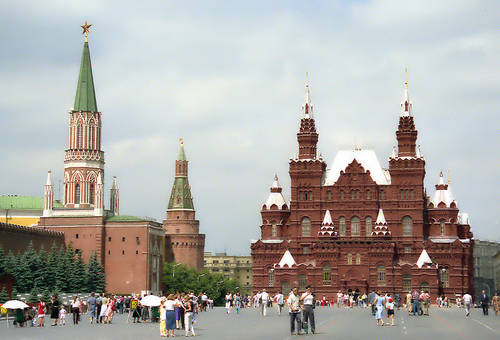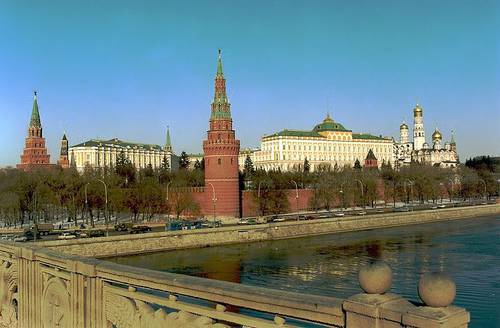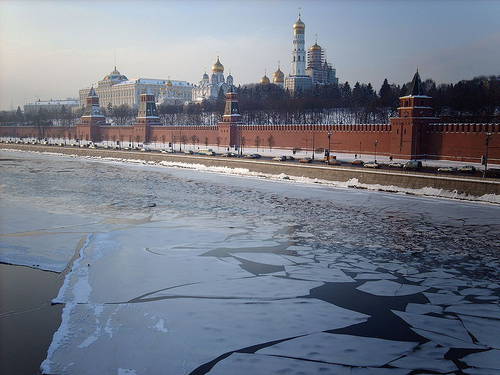Moscow

Anyway, Moscow does not leave its unweakened position of capital and one of greatest metropolis of Europe. Within its very long history-period, which - exept of town-nucleus - remind many cathedrals and more than 60 university buildings, the town passed through many rebelions in Tsar and USSR period. Frankly speaking, we can follow Russian Soul everywhere. A slogan ?Vsjo bolschoje? (we can take it as one of Russian symbols) you meet really on each place. Big buildings were characteristic and privileged mainly for previous regime. However, present system with its ostentations palaces and planned glassed skyscrapers is very similar to those previous. Contemporaneous Russia lives through - from sociological point of view - some way of division, where middle class of inhabitants runs into higher sphere, or - on the contrary- falls down into unenviable stage, distant from luxurious wealth of Moscowits, some Post-Soviet elite of big nation, which - except of world-expansion in past years - improves its immortal Mother Moscow.
If you decide visit Moscow, you can choose between two extremes. Your journey in summer will be surprisingly hot, and, with small exceptions, Moscow summer can be compared with weather conditions in our country. On the contrary, winter here has really its frozen face. Who does not prefer chilly Christmas days in Bohemia, he would travel to Moscow at that time. Spring, as well as autumn are some transitional periods, when it rains often here, and morose Moscowits are more frowning.
There are two ways of travelling to Moscow (there exist more ways, of course) but we wish to warn the tourists to avoid travelling by car (from many basic reasons). Most usual way, by plain, terminates on Sheremetyevo-airport, securing international flights to all world destinations, and especially to Asia. More courageous tourist choose travelling by train (fast trains R 209/22) with departure from Prague-Central Station always at 22,56 h and R 605/203. Both trains are consisted of sleeping carriages only, (the second one has its departure from Cheb. The reason is: obvious popularity of West-Bohemian spas among Russian visitors!). 2000 kms long way by train takes 30 hours approx. (according to time-table) and travellers can see - from train windows - the towns of Brest, Minsk or Smolensk. The other connection - via Berlin and Warsaw - is popular, too.
We are in Moscow, on Belorusskaya station or Sheremetyevo airport. The way into city-centre (where there live approx. 12,5 millions of inhabitants) leads through dirty, unclear and endless quarters of houses. Here, there are living standard inhabitants of Moscow. Local population is consisted from mix of hundreds of various Asian and European nationalities. It is quite difficult to say who is a real Moscowita or not. Anyway, you are not to be afraid of any attack. A visitor meets famous Slavonic sympathy, enorm pleasure for help and warm hospitality. However, many Russians wish that this service would be valued and paid for. Who has the intention to travel in any part of Russian countryside on one´s own accord, he would have many gifts and bribes available, otherwise it is absolutely impossible to continue in travelling.
The interesting place in Moscow city centre is Arbat, living bazaar and market place, shopping centre of habitual citizens, where you easily loose your way in people´s masquerade. On the contrary, New Arbat is a very luxurious version of old market place, a symbolic contrast, as here habitual Russian does not do his shops, he does not have enough money available.
In past, an old Arbat was a centre of culture, art and literature, changed in living centre of ?flea-market?, reminding similar markets on Seine banks in Paris. Moscow undergone (similarly as Paris) enormous development during last 200 years. This fact is proved with four city traffic-circuits (they pass through new arising house-quarters and industrial zones). Highway outflankings as well as high-speed railway follow town custom-frontier of 18th century. Green circle of gardens follows a line of ancient fortification and inland circle of wide boulevards binds even ?Kitai gorod?, historical town-nucleus, founded on rectangular ground-plan. In its centre, there is situated a triangle fortress of Russian Empire - Cremlin. This building, together with famous ?Krasnaya Ploščad? (Red Square) was registered in World Heritage Fund (UNESCO) in 1990.
The history of town comes to 1147 (there was found a first written notice). Yuri (George) Dolgoruky invited his ally, Svatoslav - Novgorodsko-Northern Prince-for a meeting into stronghold, named Moscow in his invitation letter. Consequently, George let to have constructed his principality with fortifications and moats, in order to strenthen the borders of his dominion. He could not forsee, in any case, that in such way there was established a fortress of Soviet dictatorship, Cremlin.
This word meant, in old Russia, the name for town´s castle or a fortress. Similar buildings with this name were in each town in Russian territory but Cremlin in Moscow is most famous and became a bastion of many generations of monarchs which ruled the destiny of whole great Empire. The outside walls of Moscow Cremlin, high from 5 to 17 meters, are made of burned bricks. Total length of walling, strengthened with twenty towers, makes more than two kilometers. Inside of fortress, you find most important Russian churches - as for instance - Church of Virgin Mary of 15th century and a Cathedral of Archangel Michael (Archangelski Sobor), where you can see tombs of Tsars. Except of important churches in Cremlin, you can visit beautiful historical armoury as well as boastful palaces - Bolshoi Kremliovsky Dvorec - finished in 1849. Cremlin area, where are kept (except personal rooms of Tsars) numerous historical treasuries of Russian Empire. The buildings were built mostly by Italian masters, invited here by Tsar Ivan III. in 15th century. Anyway, many other important buildings preserved till now, situated nearby Res Square and along river banks, aside buildings of Neo-classical style of first half of 20th century.
A year 1712 became quite important period in town´s history. At that time, competitive town of St.Petersburg, was declared by Tsar Peter I. Great, as new capital of Russia. At the same time, it was not allowed, to construct in Moscow stony houses. Despite of this interference with, the town kept its economical, political ans mainly cultural importance. Further of later interferences came in 1812, when Napoleon troops conquered partially deserted town, which Russian commander Kutuzov let to evacuate. However, rests of inhabitants let get into fire. Definitive destruction was terminated in a moment when the troops, leaving town´s ruins (the citizens did not given them nor assistance nor foodstuffs), destroyed Cremlin, including many other important buildings.
 However, similar proceedings were repeated within Stalin rule-period. Many beautiful cathedrals and churches were destroyed, in order not to prevent the construction of monumental memorials and congress palaces for establishment of that time period. One of that monuments there was a Cathedral - Sanctuary of Jesus Christ Saviour. Its construction took 45 years ( during rule of Tsar Nicholaus I.). Its construction was done as thanksgiving to Lord´s Son for a fact that he protected Russians against French troops during War with Napoleon troops. This monument existed 48 years only. Stalin had destroyed it. On this place, a Palace of Soviets, would have to be built, planned as highest building all over the world, decorated with Lenin statue, six times higher as Empire State Building in New York, as well as Statue in Liberty in USA. Shoulders of Lenin statue could have been 32 m wide! Total height of planned construction could have been 415 metres, with 150 storeys!
However, similar proceedings were repeated within Stalin rule-period. Many beautiful cathedrals and churches were destroyed, in order not to prevent the construction of monumental memorials and congress palaces for establishment of that time period. One of that monuments there was a Cathedral - Sanctuary of Jesus Christ Saviour. Its construction took 45 years ( during rule of Tsar Nicholaus I.). Its construction was done as thanksgiving to Lord´s Son for a fact that he protected Russians against French troops during War with Napoleon troops. This monument existed 48 years only. Stalin had destroyed it. On this place, a Palace of Soviets, would have to be built, planned as highest building all over the world, decorated with Lenin statue, six times higher as Empire State Building in New York, as well as Statue in Liberty in USA. Shoulders of Lenin statue could have been 32 m wide! Total height of planned construction could have been 415 metres, with 150 storeys!
Let´imagine, that Napoleon, for instance, could let destroy Notre  Dame Cathedral, and instead of it let bult his monument, or Mussolini could did similar nonsence, to destroy St.Peter´s Basilica in Rome! However, all this was possible in USSR, moreover, at that time died from hunger many people in Ucraine. So, highest construction of world was not built from political reasons. On place, where there was a church, was built, according the advice of Khruscew, swimming-pool.
Dame Cathedral, and instead of it let bult his monument, or Mussolini could did similar nonsence, to destroy St.Peter´s Basilica in Rome! However, all this was possible in USSR, moreover, at that time died from hunger many people in Ucraine. So, highest construction of world was not built from political reasons. On place, where there was a church, was built, according the advice of Khruscew, swimming-pool.
Red Square is big symbol and main centre of events of the whole country. Here, in recent time, there was demonstrated a military power of Russia by means of military parades. The square divides Cremlin and Kitai-gorod, historical nucleus with most of monuments, surrounded with fortifications since 16th century. Originally, there stood wooden houses, but these were demolished by Tsar Ivan III in 1493, owing to possible danger of fire. So, new founded space became a market-place later.
Red Square, as we know it now, got its face at the beginning of 20th century, within Revolution time-period, when Soviet Union was established. In 1929, Lenin Mausoleum was created. Each citizen of Russia would visit this monument once in his life, at least. Up to now, mortal frames of Lenin. first man of Great October Revolution, are visited by many tourists, Russians and from abroad. Anyway, not many people know that Comrade Stalin was placed after his death aside Lenin in Mausoleum in 1953. However, he crumbled completely later, and finished similarly as his Personality Cult and later the whole Empire.
 It is not necessary to mention the Cathedral of Vasil Blissful. Its architecture symbolises joining Russia with Europe and Asia. Church was constructed within 1555-1560, according to order of Ivan Terrible, as a remind of victory over Khan of Kazan. This fact confirms number of towers, from eight more-less independent churches, symbolising days of decisive battle in Kazan. In 1588, there was added a chapel of Basil Blissful, which gave the whole construction its second name. Originally, its name was Pokrovsky Cathedral. With arrival of Bolsheviks in 1929, the cathedral was closed and freed from bells.The cathedral waited for its operation renewal till 1990, when regularly Orthodox Masses started to be served.
It is not necessary to mention the Cathedral of Vasil Blissful. Its architecture symbolises joining Russia with Europe and Asia. Church was constructed within 1555-1560, according to order of Ivan Terrible, as a remind of victory over Khan of Kazan. This fact confirms number of towers, from eight more-less independent churches, symbolising days of decisive battle in Kazan. In 1588, there was added a chapel of Basil Blissful, which gave the whole construction its second name. Originally, its name was Pokrovsky Cathedral. With arrival of Bolsheviks in 1929, the cathedral was closed and freed from bells.The cathedral waited for its operation renewal till 1990, when regularly Orthodox Masses started to be served.
As to further Moscow dominantas: it is a sender, nice and non-typical monument of commander and Tsar Peter I. Great. Progress and success in cosmos conquest remind statues of cosmonauts, especially the first Cosmonaut Gagarin and Vostok Rocket.
Near Gorki Park, you find a copy of Rocketship Buran (this machine never took, however, human´s crew into cosmos). Except of new established luxurious skyscrapers, there is rising majestic Moscow State University of M.V.Lomonosov, centre of Russian civilizatio n, where more than 35 thousands of students are studying and more than 9 thousands of teachers are teaching and lecturing. 11 graduated of this prestigious institute obtained Nobel Prize. 350 independent cathedras are in one faculty...
n, where more than 35 thousands of students are studying and more than 9 thousands of teachers are teaching and lecturing. 11 graduated of this prestigious institute obtained Nobel Prize. 350 independent cathedras are in one faculty...
Moscow has its own special atmosphere. As to popularity, it was surpassed by St.Petersburg. In spite of this, there is rich cultural sphere a lot of marvellous and noble things, in contrast to standard and grey way of life of great nation. First of all, Moscow is a cultural centre. Bolshoi Theatre is world-know and excellent theatre, Moscow Underground has probably most delightful stations of the world, and in general: it is beyond your power to visit all local museums within your one stay here only: All is too great! (vsjo bolshoie!)
Text: Jan Chaloupka
Photo: Wikimedia Commons, Thomas Glau, Filtv, timsdad, Monedula, David Crawshaw, Stan Shebs, Laban66, Gérard Janot, Gérard Janot, Smack, Quistnix, Stan Shebs
| Discussion at the article (0) |
Related Articles

A Journey To Siberia - Ekaterinbourg

Russia, Moscow – Visiting Lenin

Russia: Rostov – City on Lake Nero

Russia: Red Square, The Heart of Moscow and the Country

Do You Know That? The Highest Statue Of The World II.

A Journey To Siberia - Nowosibirsk

Tatarstan: Kazan
Related Photogallery

St Petersburg – The Cradle of Russian Ballet

Russia: Moscow - Cradle of the Nation
Guide:
Important Information:
![]() Information and warnings on travelling abroad is to be found HERE.
Information and warnings on travelling abroad is to be found HERE.
































